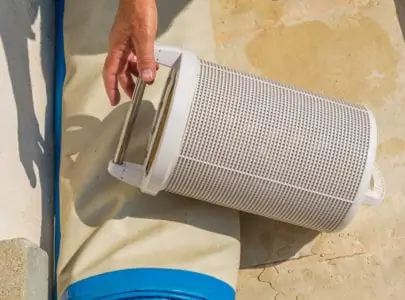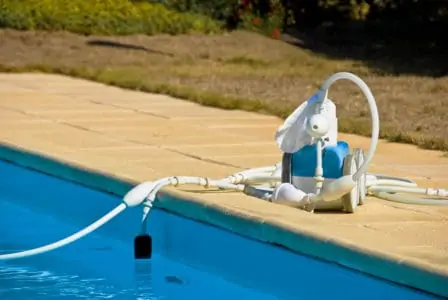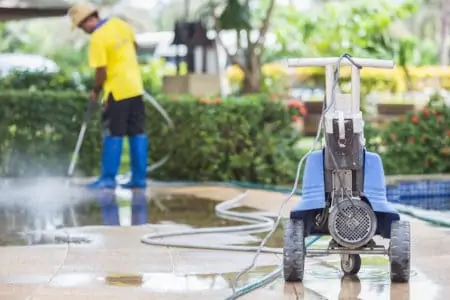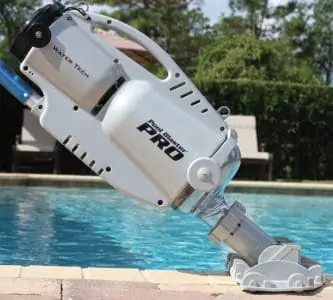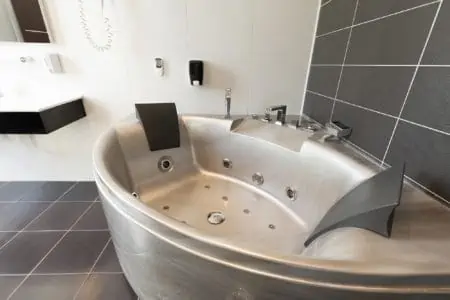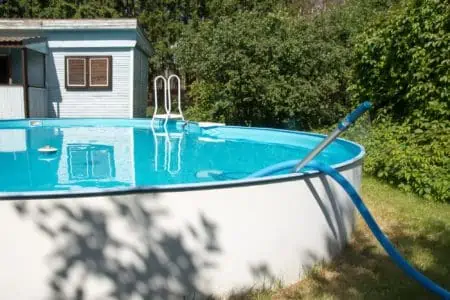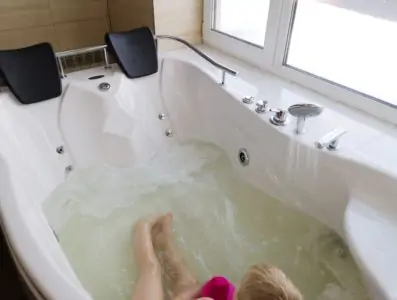Has the water in your swimming pool turned cloudy? Has it been a season or two since you’ve installed your pool filter? Then it may be time to learn how to clean a pool filter. You’ll be able to get rid of the cloudy water and enjoy swimming in a clear pool again.
Key Takeaways
- There are three types of pool filters: cartridge, sand, and diatomaceous earth (D.E.) filters.
- Cartridge pool filters should be cleaned every 6 weeks to 3 months, sand filters should be backwashed every 1-4 weeks, and D.E. filters should be cleaned every 1-3 months.
- Replace pool filters when they are torn, cracked, or when the pressure of a cleaned filter is 6 PSI higher than when it was first installed.
- Regular pool maintenance, including skimming debris, checking chemical levels, vacuuming, and brushing tiles and walls, helps reduce wear and tear on your pool filter.
Different Types of Pool Filters
There are three types of pool filters used to keep the pool water clean. They are the cartridge pool filter, the sand pool filter, and the diatomaceous earth or D.E. filter. All three pool filters can be either in the ground or above ground.
Cartridge Pool Filter
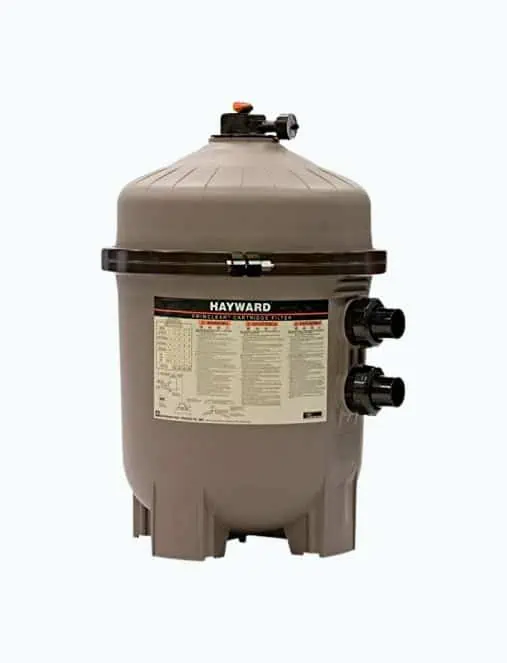
A cartridge pool filter uses a cloth material to filter the pool water and can trap particles as small as 25 microns in size. It doesn’t require backwashing, and the cartridges are reusable.
Sand Pool Filter
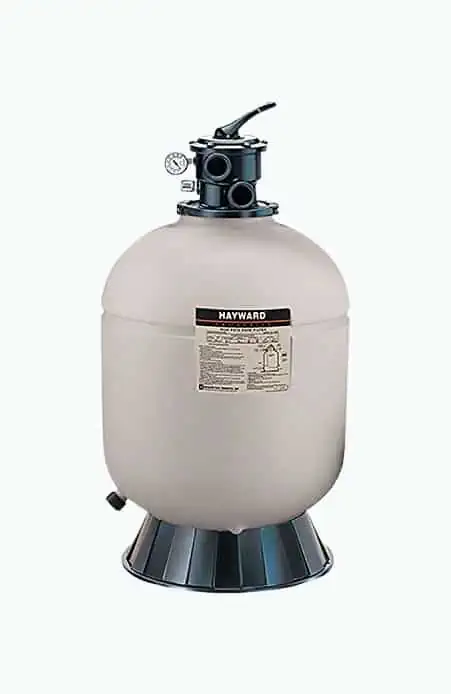
A sand pool filter, filters the water through sand and can trap particles as small as 20-30 microns in size. This type of filter requires regular backwashing.
Diatomaceous Earth Filter
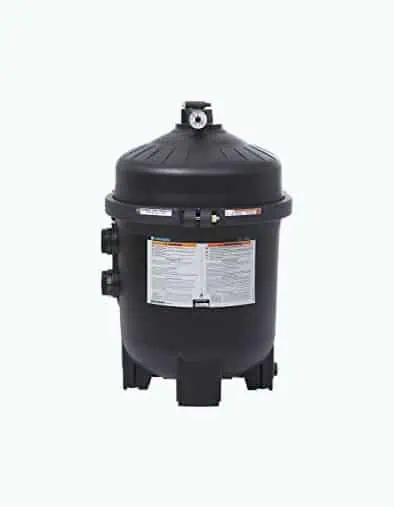
The diatomaceous earth filters use a naturally occurring soft sedimentary rock that can be easily crumbled into a powder to filter the pool’s water. It will trap particles as small as 3-5 microns in size allowing a pool to become crystal clear. It also requires regular backwashing.
Homemade Pool Filter Cleaning Solution
You can make your own DIY pool filter cleaning solution by mixing a cup of either dish soap or dishwasher detergent in 5 gallons of water. Alternatively, you can also make the homemade pool filter cleaning solution by mixing 1 cup of trisodium phosphate (TSP) in 5 gallons of water.
How to Clean a Pool Filter Cartridge
A pool filter cartridge is fairly easy to clean. First, you will need to remove the pool filter from its housing before you will be able to clean it.
- Time: An afternoon or weekend
- Difficulty: Beginner
What You’ll Need
- Garden hose
- Spray nozzle
- Wrench set
- Pool filter cleaner
- 5-gallon bucket or garbage can
- O-ring lubricant
- Rubber mallet
- Owner’s manual
How to Remove Pool Filter
1. Turn Off The Pump
Turn off the pump before closing all the inlet and outlet valves that flow in and out of the pump. Open the air-relief valve at the top of the pump to avoid a vacuum from developing.
2. Open Housing and Remove Top of Filter
Open the housing of the pump by removing the bolt holding the clamp together. You may need a rubber mallet to gently hit and loosen the clamp if it’s stuck together. Now remove the top of the filter.
3. Remove Cartridges
Remove the cartridges. You may need to use a rocking motion to get them out of the housing. Inspect the cartridges for any wear or damage. If a cartridge is mushy, torn, or cracked, you will need to replace it.
Now it’s time to clean the filters.
How to Clean the Filter
1. Place Cartridges On Grass
Quite a bit of debris such as dead leaves and silt will be removed from the cartridges, so it’s easier to place them on the grass. This will save time cleaning up the debris after you’ve cleaned the cartridges.
2. Hose Off the Cartridges
Use the garden hose and spray nozzles to hose off the cartridges. Try to maintain a 45-degree angle to prevent damaging them. Work to flush the debris between the pleats.
If necessary, you can brush the pleats to remove any small particles that are difficult to remove.
3. Soak the Cartridges
If the cartridges are filthy, you may need to soak the cartridges in a pool filter cleaning solution. Put the cartridges into the solution and allow them to soak overnight.
4. Rinse and Clean the Filter Housing
While the cartridges are soaking, rinse and clean the filter housing.
5. Rinse Cartridges and Replace in Housing
After the cartridges have soaked overnight, rinse them before returning them to the filter housing. Fasten the cartridges into place and put on the top of the housing. Make certain everything is fastened into place.
6. Check O-Ring
Check the o-ring. If it’s in good shape, then lubricate it. If it’s damaged, then you will need to replace it.
7. Turn On System
Turn on the system and open the air relief valve. Leave the valve open until a steady stream of water sprays out of it. Close the valve.
The final step is to double-check the system pressure to make certain it has returned to the normal range. If not, check the owner’s manual to troubleshoot and correct the issue.
How to Clean a Sand Pool Filter
If you notice that your pool is developing cloudy water or the pressure of your filter has increased by 10PSI, it is probably time to clean your sand pool filter. Here’s how to clean a pool filter easily.
- Time: Overnight
- Difficulty: Beginner
What You’ll Need
- Backwash hose
- Sand filter cleaner
- Bucket of water
- Owner’s manual
1. Backwash the Filter
The first step is to backwash your sand pool filter to remove any debris that may be in the filter.
2. Add Sand Filter Cleaner
Turn off your pump first. Then make sure that the 2-way valve is set to filter, not backwash. Remove the strainer’s lid and pour the sand filter cleaner into the strainer’s basket or skimmer. Slowly pour a bucket of water over into the strainer’s basket to help the cleaner circulate. Replace the lid.
Turn the pump on for a few seconds, about 10-20 seconds, to make sure that the sand filter cleaner has been moved into the filter. Turn the pump off again.
3. Allow Pump to Rest Overnight
Allow the pump and filter to soak for at least 8 hours if not overnight.
4. Backwash Filter Again
Backwash the filter again for 5 minutes to remove the chemicals and any filter cleaner residue left in the sand. Turn off the pump.
5. Rinse the Filter
Turn the filter to the rinse setting and allow it to rinse for about 30 seconds. Then return the filter to the normal filter position and turn your system back on.
Your pool is ready to be used again.
How to Clean a D.E. Pool Filter
The diatomaceous earth filters are the most efficient pool filters available and should be backwashed every 4-6 weeks. However, your filter will still need to be cleaned every season or when the gauge reads 10 psi above what it read when it was installed or last cleaned. Here’s how to clean your swimming pool D.E. filter.
- Time: An afternoon
- Difficulty: Intermediate
What You’ll Need
- Backwash hose
- Garden hose
- Spray nozzle
- O-ring lubricant
- Wrench set
- 5-gallon bucket
- Large plastic spoon
- D.E. filter cleaner
- D.E. powder
- Owner’s manual
1. Backwash the Pump
The first step to washing your D.E. pool filter is to backwash the pump for 3-5 minutes. This will remove any debris in the system.
2. Turn Off the Pump and Remove the Drain Plug
Turn off the pump, make sure the backwash valve is pointing to the filter, and open the air relief valve. Then remove the drain plug and allow the water in the filter tank to drain out.
3. Remove Filter Manifold and Grids
Remove the clamps or latches holding the filter together. If you’re not certain how to do this, refer to your owner’s manual. Once you’ve removed the clamps, open the filter tank by taking the top half off.
Remove the filter manifold and all the grids from the filter.
4. Clean Filter Tank, Filter Manifold, and Grids
Rinse the filter tank with a garden hose. Replace the drain plug.
While the filter manifold and the grids are out of the filter tank, use a spray nozzle on your hose to clean them. You may need to use a D.E. filter cleaner if the filter manifold is filthy. Be sure to follow the manufacturer’s instructions and use appropriate safety equipment.
Rinse the grids well and make sure all debris and the D.E. powder have been removed.
5. Inspect Grids and Manifold
Inspect the grids and the manifold for cracks, tears, and damage.
6. Replace Filter Manifold and Grids
Replace the filter manifold and grids back in the filter tank. Tighten the nuts, but be careful not to overtighten them. If you have a standpipe O-Ring, you will need to replace it.
Lubricate the O-Ring inside the filter tank before returning the top half of the filter tank to its original place.
7. Add D.E. Powder to Filter Tank
Check the owner’s manual of your filter tank to determine how much D.E. powder you will need to use. Then use a clean bucket and large plastic spoon to mix the powder with enough water to make a slurry, it should be the same consistency as milk. Do not add the powder to the tank yet.
8. Prime the Filter Pump
Remove the strainer housing lid and fill the strainer housing with water. Make sure some water runs through the incoming line. You may also need to lubricate the pump lid’s O-Ring.
Close the strainer housing lid now.
9. Turn On the Pump
First, open the filter air-relief valve to release any excess air from the filter tank. Then start the pump and allow it to run for a minute or two. This will make sure that you have circulation.
Close the filter air-relief valve when water runs out of it.
10. Add the D.E. Slurry
Now slowly pour the slurry mixture into the pool skimmer and let the pump continue running for another 30 minutes. This will allow the D.E. to spread evenly over the filter’s grids.
Doublecheck to make sure that you don’t have D.E. returning to the pool from the return line.
If this happens, you may have a hairline crack in one of the grids or the manifold. It’s also possible you need a new gasket or O-ring. If necessary, call a licensed pool service professional to examine your filter.
How Often to Clean Pool Filter
Pool filters vary in how often they need to be cleaned. The temperature, amount of use, and size of the pool will influence when you need to clean the pool filter. The best way to tell is to keep an eye on the pressure gauge.
When the pressure in your pool has increased by 8-10 PSI over the pressure after the filter was installed or last cleaned, your pool filter needs to be cleaned again.
You’ll also want to check to see if your pool filter needs to be cleaned if your pool’s water turns cloudy.
In general, a cartridge pool filter should be cleaned every 6 weeks to every 3 months. A sand filter should be backwashed every 1-4 weeks, and deep cleaning of the sand twice a year. A D.E. filter should be cleaned every 1-3 months.
How Do You Know When to Replace Your Pool Filter?
Replace your pool filter when it is torn or cracked. Check for seams that are coming apart or holes in the filter as well. Other signs that you may need to replace your pool filter are when the water is cloudy and when the pressure of a cleaned filter is 6 PSI higher than the pressure of the filter when it was first installed.
Pool Filter Maintenance Tips
- Skim debris such as leaves, branches, and flowers from your pool frequently. This will reduce the wear and tear on your pool filter.
- For a simple degreaser, drop a tennis ball in your pool. The tennis ball will soak up any oils that end up in your pool keeping the oils out of your filter.
- Check the chemical levels of your pool frequently. The right water balance is important for the upkeep of your pool filter.
- Vacuum the pool and brush the tiles and walls every week. This will help to keep your pool clean and make it easier to keep the algae under control and out of your pool filter.
- Know the pressure of your filter when it’s clean so you know when it’s time to deep clean or replace your filter.
- Backwash your filter once a month.
